Jump leads for 4.4L V8 diesel?
Discussion
gazza285 said:
paralla said:
Just leave them connected for a few minutes before trying to start the car with the flat battery.
This. I was taught to let the battery charge for a bit, not to use jump leads for starting. Something that seems to have been overlooked is the fact that bigger is better although it doesn't stand when penis size is being discussed
Jump leads are often used for starting other vehicles, the owner of 50mm² leads can safely jump start engines that have bigger starter motors than their own vehicle has
There is a big difference in volt-drop when comparing 5 meter lengths of 50mm² leads with 5 meter lengths of 35mm²
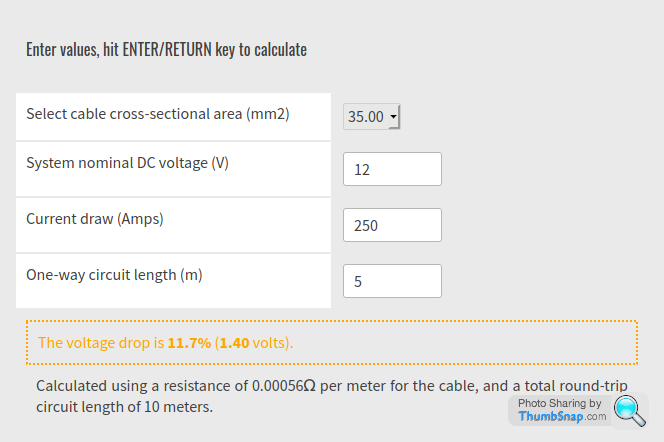
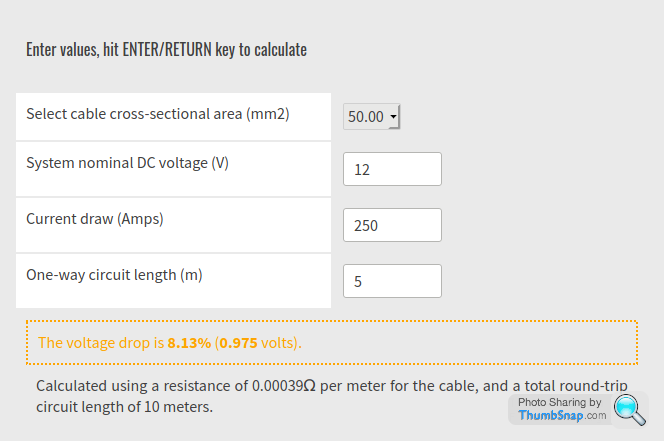
Penelope Stopit said:
Agreed, getting some charge into the flat battery for several minutes before cranking the engine over makes a massive difference
Something that seems to have been overlooked is the fact that bigger is better although it doesn't stand when penis size is being discussed
Jump leads are often used for starting other vehicles, the owner of 50mm² leads can safely jump start engines that have bigger starter motors than their own vehicle has
There is a big difference in volt-drop when comparing 5 meter lengths of 50mm² leads with 5 meter lengths of 35mm²


The quality of the cables and leads also play as much of a difference to the end voltage as the cables doSomething that seems to have been overlooked is the fact that bigger is better although it doesn't stand when penis size is being discussed
Jump leads are often used for starting other vehicles, the owner of 50mm² leads can safely jump start engines that have bigger starter motors than their own vehicle has
There is a big difference in volt-drop when comparing 5 meter lengths of 50mm² leads with 5 meter lengths of 35mm²


So you'd be better with a higher quality 35mm lead then a low quality 50mm
I have a old set made from household mains incoming wiring probably around 40-50mm core buts made from around 7 strand's so no very flexible
Chris32345 said:
The quality of the cables and leads also play as much of a difference to the end voltage as the cables do
So you'd be better with a higher quality 35mm lead then a low quality 50mm
I have a old set made from household mains incoming wiring probably around 40-50mm core buts made from around 7 strand's so no very flexible
Agreed, there's much rubbish on the marketSo you'd be better with a higher quality 35mm lead then a low quality 50mm
I have a old set made from household mains incoming wiring probably around 40-50mm core buts made from around 7 strand's so no very flexible
Nice job with the mains cable, flexibility doesn't matter for now and again jumping
Rockatansky said:
These jump leads get good reviews on amazon, various sizes.
https://www.amazon.co.uk/KRI%C3%8BGER-Battery-Mete...
That's a very good price, can't find any cheaper, 16 Meters of 50mm² Copper clad aluminum cableshttps://www.amazon.co.uk/KRI%C3%8BGER-Battery-Mete...
Don't know where the 800Amp current rating comes from, don't know anything about copper clad aluminum cables hence can't comment
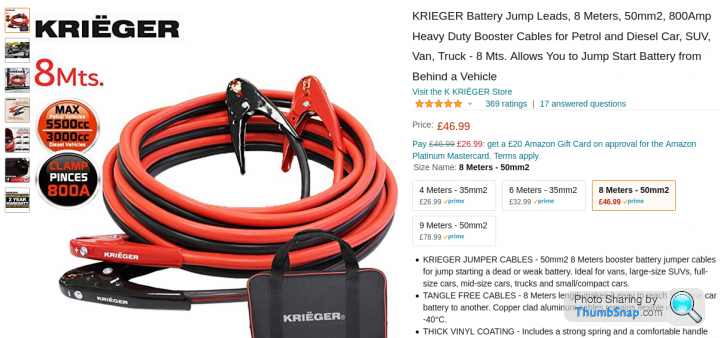
as the name suggests - it’s aluminium cable with a very light coating of copper - i would avoid them just on principle.
I just searched my purchase history because I made my own after researching things and i’m using 35mm2 welding cable which is listed as capable of 290amps
I also purchased half decent clamps that have an internal braid between the two sides of the jaws.
My 5.7 chevy pulls around 200amps on cranking according to my current clamp.
eta - they are not jump leads, it’s a big 90Ah AGM battery with 1.2m long leads as HD jump pack
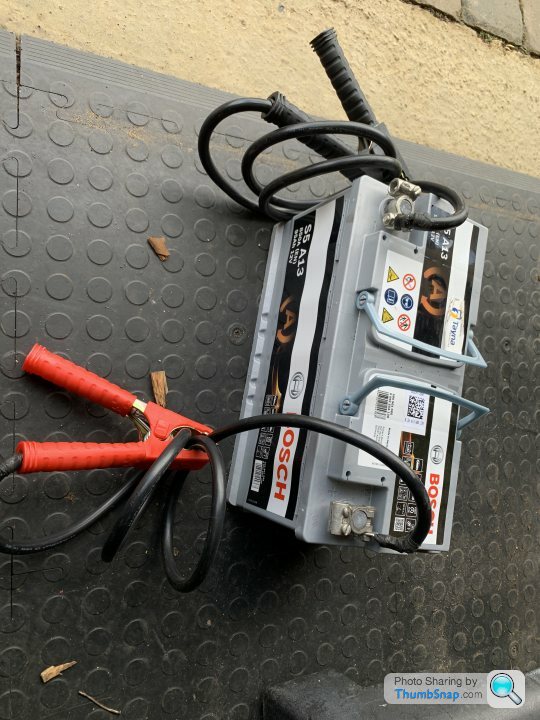
I just searched my purchase history because I made my own after researching things and i’m using 35mm2 welding cable which is listed as capable of 290amps
I also purchased half decent clamps that have an internal braid between the two sides of the jaws.
My 5.7 chevy pulls around 200amps on cranking according to my current clamp.
eta - they are not jump leads, it’s a big 90Ah AGM battery with 1.2m long leads as HD jump pack

Edited by eliot on Sunday 21st March 10:17
Edited by eliot on Sunday 21st March 10:18
eliot said:
as the name suggests - it’s aluminium cable with a very light coating of copper - i would avoid them just on principle.
I just searched my purchase history because I made my own after researching things and i’m using 35mm2 welding cable which is listed as capable of 290amps
I also purchased half decent clamps that have an internal braid between the two sides of the jaws.
My 5.7 chevy pulls around 200amps on cranking according to my current clamp.
eta - they are not jump leads, it’s a big 90Ah AGM battery with 1.2m long leads as HD jump pack

NiceI just searched my purchase history because I made my own after researching things and i’m using 35mm2 welding cable which is listed as capable of 290amps
I also purchased half decent clamps that have an internal braid between the two sides of the jaws.
My 5.7 chevy pulls around 200amps on cranking according to my current clamp.
eta - they are not jump leads, it’s a big 90Ah AGM battery with 1.2m long leads as HD jump pack

Your jumping machine gets a green light with a volt-drop of only 0.269 volts which is well below the maximum acceptable drop of 0.75 volts on the starter motor positive supply side of the circuit and very close to the maximum acceptable drop of 0.25 volts along the earth return side
This is for flexible battery cable not for your welding cable that has thicker insulation for higher voltages and possible better conductivity
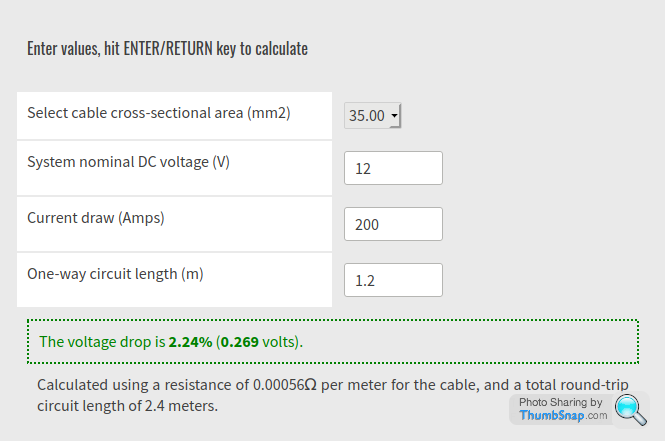
Out of interest - Why would you avoid the copper coated aluminium cables in the advert for now and again home use? I know zilch about them and have only ever used copper
Oh no, failed on a 5 Meter length calculation (battery cable though, not welding cable)
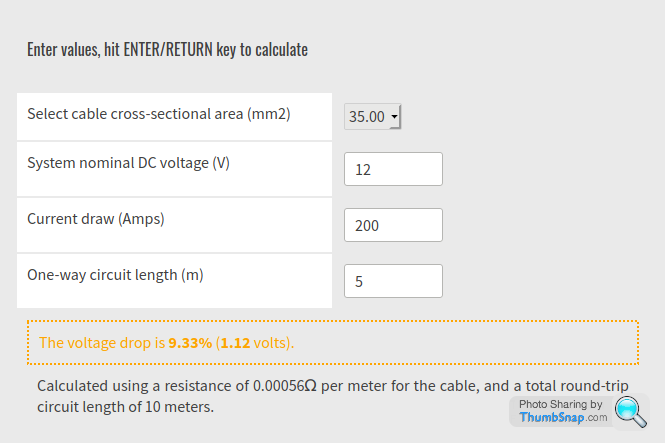
Edited by Penelope Stopit on Sunday 21st March 11:10
Never even noticed it say copper clad aluminium. That would certainly offer lower performance than straight up copper welding cable. Good spot. That is definitely a negative and they've done it for cost reasons.
And household cable is a poor choice, thick or solid strands do not conduct as well as very thin strands, plus the lack of flexibility is also a negative from a practical standpoint.
Multi-stranded cable like welding cable ( aka tri-rated ) is a far superior conductor than lower count, thick strands.
Really...there's no need to overthink it. Good cables made from 35mm^2 welding cable, copper.....will be more than enough to start pretty much any engine, in any car or jeep.
And household cable is a poor choice, thick or solid strands do not conduct as well as very thin strands, plus the lack of flexibility is also a negative from a practical standpoint.
Multi-stranded cable like welding cable ( aka tri-rated ) is a far superior conductor than lower count, thick strands.
Really...there's no need to overthink it. Good cables made from 35mm^2 welding cable, copper.....will be more than enough to start pretty much any engine, in any car or jeep.
eliot said:
Penelope Stopit said:
Out of interest - Why would you avoid the copper coated aluminium cables in the advert for now and again home use? I know zilch about them and have only ever used copper
What does your csa calculator give for ally as opposed to copper?ρ = Specific resistance or resistivity of Conductor
D = Distance in Feet (One way) i.e. ½ the total circuit length
I = Load Current
Note: the Value of ρ = Specific resistance or resistivity of Conductor is used here for copper and aluminum is 11.2 and 17.4 respectively at 53° C (127° F)
Certainly does show a vast difference in conductivity between copper and aluminium
Mmm, is this why you wouldn't go for the leads in that advert?
You've now go me questioning the specification of those copper coated ally leads, even putting aside the 800 Amps mentioned as that is definitely suspect
Love this stuff, always learning and doing my brains in
cheers
What do you think?
If you just wait a few minutes for the charging battery to transfer some charge to the flat battery before hitting the starter motor of the car with the dead battery the current in the cable and charging battery is significantly reduced so cable resistance and voltage drop are also of less consideration.
It’s also much safer because of the reduced current and much less likely to explode the charging battery.
It’s also much safer because of the reduced current and much less likely to explode the charging battery.
eliot said:
It’s just ohms law V= I x R
copper is about .5 ohms per Km and Ally is about .75 ohms per Km
Meant what do you think about those cables in the advert?copper is about .5 ohms per Km and Ally is about .75 ohms per Km
The difference in conductivity of copper and aluminium make those leads look ????????????????????
This has brought back memories of when I was a nipper, aluminium coils started turning up in starter motors and it was difficult to replace the brushes that connected to them, had to leave some of the copper brush tails on the coils and solder new ones to them, the original connection was much like a spot weld
Never even gave it a thought about the conductivity of aluminium starter motor coils, much lighter though and they did do the job
Them were the days, used to have competitions to see who could repair each model of alternator and starter motor the quickest
paralla said:
If you just wait a few minutes for the charging battery to transfer some charge to the flat battery before hitting the starter motor of the car with the dead battery the current in the cable and charging battery is significantly reduced so cable resistance and voltage drop are also of less consideration.
It’s also much safer because of the reduced current and much less likely to explode the charging battery.
Agreed, the method makes a massive differenceIt’s also much safer because of the reduced current and much less likely to explode the charging battery.
With a username like yours you obviously always connected them up in parallel
I'm in the breakdown recovery industry and we are using jump leads day in day out, on 12v and 24v. The leads that we make are usually 35mm2 copper core and they are more than adequate to do the job on the pretty much anything. Most are connected via 175amp Anderson plugs to the donor vehicle and again this is more than on top of the job.
Holy thread resurrection.
I drove car transporters for years, the worse vehicles we found to jump start were 2.5/3 litre Diesels as fitted to Transits/Terranos/Discos etc, the 4.4 V8 wasn't in the running back when i was on defleet work.
Had really good jump leads, they had to be long because flat battery might be on the top deck or the vehicle nosed into a tight space, but in many cases no matter how powerful the donor vehicle battery one set of leads wasn't always enough, the leads i had would jump start a 12 litre lorry engine without hesitation (24v helps) but a week later wouldn't feed enough current through to start a Transit, i suspect it was more the points of contact at the clamp/battery more than the thickness of the cables, using a second set of leads in parallel worked every time.
So, after that long winded waffle, my suggestion is to have 2 sets of reasonable quality leads so if one set doesn't do the job you can add the second to the mix.
Good point from Matt aboove, at car compounds the minibuses used by the yardies have perma fixed leads, these seldom have any issues starting vehicles...and they never bother with any of the precautions often suggested about jump starting, one bod holds the clamps to the battery whilst another starts the car.
One word of warning, always always make sure the drivers door is open before attaching jump leads to the flat battery, or have the car keys on your person, some cars will auto fire up the central locking when you connect power.
I drove car transporters for years, the worse vehicles we found to jump start were 2.5/3 litre Diesels as fitted to Transits/Terranos/Discos etc, the 4.4 V8 wasn't in the running back when i was on defleet work.
Had really good jump leads, they had to be long because flat battery might be on the top deck or the vehicle nosed into a tight space, but in many cases no matter how powerful the donor vehicle battery one set of leads wasn't always enough, the leads i had would jump start a 12 litre lorry engine without hesitation (24v helps) but a week later wouldn't feed enough current through to start a Transit, i suspect it was more the points of contact at the clamp/battery more than the thickness of the cables, using a second set of leads in parallel worked every time.
So, after that long winded waffle, my suggestion is to have 2 sets of reasonable quality leads so if one set doesn't do the job you can add the second to the mix.
Good point from Matt aboove, at car compounds the minibuses used by the yardies have perma fixed leads, these seldom have any issues starting vehicles...and they never bother with any of the precautions often suggested about jump starting, one bod holds the clamps to the battery whilst another starts the car.
One word of warning, always always make sure the drivers door is open before attaching jump leads to the flat battery, or have the car keys on your person, some cars will auto fire up the central locking when you connect power.
Edited by Smint on Sunday 20th June 07:46
stevieturbo said:
Dave. said:
Comparing their 1000A to the Amazon link. It is hard to tell from the images, but the croc clips look like they could be flimsy, and also more insulated would be betterAlso no mention at all of cable sizes used.
For those reasons alone I wouldn't even consider them

If I was using them regularly or on decent sized engines, I would have stumped up a bit more & done some proper research, but the biggest engine on the drive is a 3.5 so assumed the "6l cables" would be overkill, even if they were s
 t.
t. Besides that, it says "Professional" on the packaging, so they must be good!

only use copper - the aliminuium ones get fatigue and the cores start to fracture. jump leads are always getting wound unwound etc...
its all in the clamps. cable to clamp and clamp to battery post.
Noted in the previous replies about connecting to the battery.....
Please please please always connec the last one a negative away from the battery - chances on it happening are low but if you ever spark a hydrogen cloud near to a battery then you will really really wish you had never done it....
https://www.youtube.com/watch?v=8xbKF1SOLn0
below is a picture of a battery thats popped...
the hydrogen exploded within the battery - now this would have sprayed acid around the immediate area, and that acid coud have ended up over anyone right beside it, or in the eyes of someone standing over it...

so be careful !
its all in the clamps. cable to clamp and clamp to battery post.
Noted in the previous replies about connecting to the battery.....
Please please please always connec the last one a negative away from the battery - chances on it happening are low but if you ever spark a hydrogen cloud near to a battery then you will really really wish you had never done it....
https://www.youtube.com/watch?v=8xbKF1SOLn0
below is a picture of a battery thats popped...
the hydrogen exploded within the battery - now this would have sprayed acid around the immediate area, and that acid coud have ended up over anyone right beside it, or in the eyes of someone standing over it...

so be careful !
These are mine:
https://atleadsandlooms.co.uk/products/battery-cab...
50 mm, 4 metre. Start bloody anything, even the local farmers tractor which is a fecking massive “Clarksons Farm” like beast.
https://atleadsandlooms.co.uk/products/battery-cab...
50 mm, 4 metre. Start bloody anything, even the local farmers tractor which is a fecking massive “Clarksons Farm” like beast.
rxe said:
These are mine:
https://atleadsandlooms.co.uk/products/battery-cab...
50 mm, 4 metre. Start bloody anything, even the local farmers tractor which is a fecking massive “Clarksons Farm” like beast.
Yep, just welding cable as already said is best and easiest to use.https://atleadsandlooms.co.uk/products/battery-cab...
50 mm, 4 metre. Start bloody anything, even the local farmers tractor which is a fecking massive “Clarksons Farm” like beast.
rxe said:
These are mine:
https://atleadsandlooms.co.uk/products/battery-cab...
50 mm, 4 metre. Start bloody anything, even the local farmers tractor which is a fecking massive “Clarksons Farm” like beast.
Nicehttps://atleadsandlooms.co.uk/products/battery-cab...
50 mm, 4 metre. Start bloody anything, even the local farmers tractor which is a fecking massive “Clarksons Farm” like beast.
There's no point in saving a few bob by buying 35mm
Gassing Station | Engines & Drivetrain | Top of Page | What's New | My Stuff


